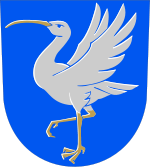Curlew
| Curlew | |
|---|---|

| |
| Long-billed curlew (Numenius americanus) Fishing Pier, Goose Island State Park, Texas | |
| Scientific classification | |
| Domain: | Eukaryota |
| Kingdom: | Animalia |
| Phylum: | Chordata |
| Class: | Aves |
| Order: | Charadriiformes |
| Family: | Scolopacidae |
| Genus: | Numenius Brisson, 1760 |
| Type species | |
| Scolopax arquata Linnaeus, 1758
| |
| Species | |
|
N. phaeopus | |
| Synonyms | |
|
Palnumenius Miller, 1942 | |
The curlews (/ˈkɜːrljuː/) are a group of nine species of birds in the genus Numenius, characterised by their long, slender, downcurved bills and mottled brown plumage. The English name is imitative of the Eurasian curlew's call, but may have been influenced by the Old French corliu, "messenger", from courir , "to run". It was first recorded in 1377 in Langland's Piers Plowman "Fissch to lyue in þe flode..Þe corlue by kynde of þe eyre".[1] In Europe, "curlew" usually refers to one species, the Eurasian curlew (Numenius arquata).
Description
They are one of the most ancient lineages of
Distribution

Curlews enjoy a worldwide distribution. Most species exhibit strong migratory habits and consequently one or more species can be encountered at different times of the year in Europe,
.The distribution of curlews has altered considerably in the past hundred years as a result of changing agricultural practices. For instance, Eurasian curlew populations have suffered due to draining of marshes for farmland, whereas long-billed curlews have shown an increase in breeding densities around areas grazed by livestock.[5][6] As of 2019[update], there were only a small number of Eurasian curlews still breeding in Ireland, raising concerns that the bird will become extinct in that country.[7]
The
Taxonomy
The genus Numenius was erected by the French scientist
The genus contains nine species:[15]
- Eurasian whimbrel Numenius phaeopus
- Hudsonian whimbrel Numenius hudsonicus
- Slender-billed curlew Numenius tenuirostris – †? (Last seen in 1995 [16])
- Eurasian curlew Numenius arquata
- Long-billed curlew Numenius americanus
- Far Eastern curlew Numenius madagascariensis
- Little curlew Numenius minutus
- Eskimo curlew Numenius borealis – †? (Last seen in 1987 [17])
- Bristle-thighed curlew Numenius tahitiensis
The following cladogram shows the genetic relationships between the species. It is based on a study published in 2023.[18]
| Numenius |
| ||||||||||||||||||||||||||||||||||||||||||||||||
The Late
The upland sandpiper (Bartramia longicauda) is an odd bird which is the closest relative of the curlews.[2] It is distinguished from them by its yellow legs, long tail, and shorter, less curved bill.
References
- ^ "Curlew". Oxford English Dictionary (Online ed.). Oxford University Press. (Subscription or participating institution membership required.)
- ^ PMID 15329156.
- ^ "How local farmers in Roscommon and their community got together to conserve a bog and protect rare birds". independent. Retrieved 2021-08-28.
- ^ "Reared curlews act like wild counterparts after release in Norfolk". BBC News. 2021-08-19. Retrieved 2021-08-28.
- ^ Encyclopedia of the Animal World (1977): Vol.6: 518–519. Bay Books, Sydney.
- ^ Cochrane, J. F.; Anderson, S. H. (1987). "Comparison of habitat attributes at sites of stable and declining Long-billed Curlew populations". Great Basin Naturalist. 47: 459–466.
- ^ Archived at Ghostarchive and the Wayback Machine: Christian TV Ireland (29 September 2019). Mary Colwell- Interview on the almost extinct Curlew bird in Ireland. Retrieved 29 September 2019 – via YouTube.
- ^ Brisson, Mathurin Jacques (1760). Ornithologie, ou, Méthode contenant la division des oiseaux en ordres, sections, genres, especes & leurs variétés (in French and Latin). Vol. 1. Paris: Jean-Baptiste Bauche. Vol. 1, p. 48, Vol. 5, p. 311.
- ^ Peters, James Lee, ed. (1934). Check-list of Birds of the World. Vol. 2. Cambridge, Massachusetts: Harvard University Press. p. 260.
- ^ Linnaeus, Carl (1748). Systema Naturae sistens regna tria naturæ, in classes et ordines, genera et species redacta tabulisque aeneis illustrata (in Latin) (6th ed.). Stockholmiae (Stockholm): Godofr, Kiesewetteri. pp. 16, 26.
- ^ Linnaeus, Carl (1758). Systema Naturæ per regna tria naturae, secundum classes, ordines, genera, species, cum characteribus, differentiis, synonymis, locis (in Latin). Vol. 1 (10th ed.). Holmiae (Stockholm): Laurentii Salvii. p. 145.
- hdl:2246/678.
- ISBN 978-0-85301-006-7.
- ISBN 978-1-4081-2501-4.
- ^ Gill, Frank; Donsker, David, eds. (2019). "Sandpipers, snipes, coursers". World Bird List Version 9.2. International Ornithologists' Union. Retrieved 26 June 2019.
- ^ "Magornitho".
- ^ "great Alaska department of fish and game".
- .
- ^ Olson, Storrs L. (1985): Section X.D.2.b. Scolopacidae. In: Farner, D.S.; King, J.R. & Parkes, Kenneth C. (eds.): Avian Biology 8: 174–175. Academic Press, New York.
- ^ Arroyo-Cabrales, Joaquín; Johnson, Eileen (2003). "Catálogo de los ejemplares tipo procedentes de la Cueva de San Josecito, Nuevo León, México" (PDF). Revista Mexicana de Ciencias Geológicas. 20 (1): 79–93. Archived from the original (PDF) on 2011-07-17. Retrieved 2007-04-29.
Further reading
- Bodsworth, Fred (1987). Last of the Curlews. Dodd, Mead. ISBN 0-396-09187-3. (originally published in 1954)
- Colwell, Mary (19 April 2018). Curlew Moon. William Collins. OCLC 1035290266.
